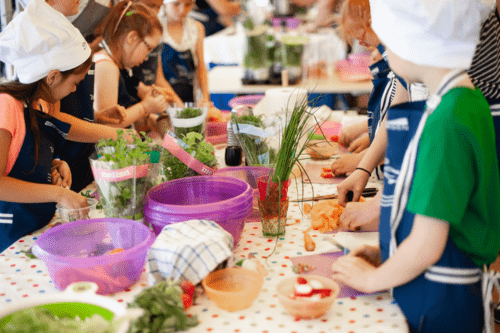In Part One of our series on Practical Life through the ages, we explored the Early Childhood exercises that help the first-plane child develop order, coordination, concentration, and independence. Given that the second-plane child has, in large part, gained these basic skills, the Practical Life area at the Elementary level shifts in its purpose. Montessori articulates the differences in From Childhood to Adolescence, writing that as the child in the first plane has “won his independence” through the Practical Life exercises:
The continuation of these exercises would be useless now that the child is independent; that is to say, he knows how to devote himself to an activity for which he will no longer need to ask help of the adult and for which he has coordination of movement.
Practical Life, therefore, looks very different for older children, although it encompasses the same major areas: care of the environment, Grace and Courtesy, and care of self and others. In this installment, we will explore some of the differences between the two levels:
- how care of the environment moves beyond the classroom walls
- curriculum connections
- how care of self extends to care of others
- additional levels of Grace and Courtesy
- correspondence of the Practical Life exercises to Erik Erikson’s psycho-social stages of development
- additional considerations for Practical Life in the second plane
Practical Life in the Elementary Classroom
As important as the Practical Life area is, it is sometimes neglected at the Elementary level in favor of more time and teacher energy spent on academics. Mary Schneider, director of the Montessori Education Institute of the Pacific Northwest (MEIPN), states in her Elementary 1 Practical Life course (2021) that:
Teachers can undervalue Practical Life because of the demands of the more academic areas, but doing so decreases the children’s interests in those areas and deprives them of options to develop a variety of skills … This is so unfortunate because these activities very much meet the need of this age group to become more skilled and independent and to build on what they already know how to do.
In fact, Practical Life at the Elementary level need not exclude time devoted to academics as many of the activities have direct connections to specific areas of the curriculum. Moreover, given the older child’s emerging sense of social and moral awareness, Practical Life at this level is also concerned with an emotionally healthy classroom climate. We’ll come back to this in a later section on Grace and Courtesy.
Care of the Environment
The older child continues to do their part in caring for the classroom environment by cleaning tables, dusting shelves, sweeping the floor or carpet, and straightening materials on shelves—all necessary for maintaining a clean and orderly space conducive to learning. Other activities related to care of the classroom, school grounds, or beyond, are often connected to curriculum areas and involve learning opportunities across a range of topics. Following are a few examples that involve a good deal more than a broom or dust rag:
The care of plants and animals is directly related to lessons in botany and zoology. Children learn about the specific needs of the organism they are caring for, potentially extending into lessons on habitat, ecosystems, and energy levels.
Related learning opportunities include:
- caring for a visiting plant or “plant of the month” to keep the interest level high and provide additional learning opportunities
- researching safe, non-toxic products to use for cleaning animal enclosures
- learning and following school policy for the disposal of used materials like dirty aquarium water or soiled hamster bedding
Starting and maintaining a garden (even a few container plants) can involve lessons in:
- botany: soil, moisture, and light needs of specific plants
- chemistry: soil mix
- math: measuring for plot area and/or containers
- health and nutrition: edible plants
Setting up and maintaining a composting system is directly related to studies in:
- ecology: the interdependence of biotic and abiotic elements
- chemistry: nitrogen and carbon components and cycles
- biology: the role of bacteria, protists, and invertebrates
- physics: temperature, moisture, aeration
It is interesting to note that while some Elementary-age children will immerse themselves completely in those activities described above, they often need reminders for simple tasks like rolling their mat neatly, tucking their chair in under the table, and returning books to the corresponding section of the library shelves. Teachers have to sometimes “draw attention to messes that have been abandoned and request clean-up” (Schneider 2021). This is because the older child has moved beyond the sensitive period for order; they are looking outward, their interests extending beyond the four walls of the classroom.
Grace and Courtesy
Grace and Courtesy continues to be an important area for older children, and we expect and hope to see them using common courteous phrases like “please,” “thank you,” and “excuse me” as good habits rather than exercises. They continue to practice waiting their turn to speak and sharing materials and classroom supplies. Additionally, the Elementary child can practice:
- welcoming visitors to the classroom and offering and preparing tea
- answering the classroom telephone appropriately
- giving school tours
- writing thank you notes to presenters, field trip chaperones, and other parent helpers
Additionally, the Elementary-age child can and should explore what is considered gracious and courteous in a variety of cultures and recognize that these practices might look very different among diverse groups of people, including those within their own classroom environment. In other words, each member of the community practices respect when addressing the diverse needs of their peers.
In this way, Grace and Courtesy takes on a new dimension at the Elementary level and is, in fact, foundational to an emotionally healthy classroom. Even in a perfectly prepared physical environment, if children are not treating peers and teachers with respect—cooperating on projects, waiting their turn, offering help, listening to a different point of view, and, importantly, cultivating empathy—the community begins to unravel and the emotional climate is not conducive to learning In this respect, Grace and Courtesy is a vital aspect of care of others. It is about problem-solving and peace-keeping and these practices become the foundation for care of the community.
Developing Social and Moral Awareness – Care of the Community
The Elementary child has a keen interest in social order, their role within a group, and the rules that govern those groups. They are beginning to understand that issues of morality are not black and white, and they feel strongly about fairness. Montessori writes that “an inner change has taken place” (Montessori 1947), and the child:
… wants to understand for himself, not content with accepting mere facts. As moral activity develops, he wants to use his own judgment, which often will be quite different from that of his teachers. There is nothing more difficult than to teach moral values to a child of this age; he gives an immediate retort to everything we say, having become a rebel.
Parents/caregivers and teachers often notice that children at this age become more argumentative, or, in Montessori’s words, “impertinent and rudely domineering.” This results, she writes, from the child’s drive toward mental independence, to distinguish right from wrong “by his own powers, and to resent limitation by arbitrary authority.”
Other developmentalists (Piaget, Kohlberg, Erikson) have suggested that children at this stage of development, and beyond, become idealistic in their thinking, taking extreme and sometimes impractical positions on a variety of moral causes and polemics. That is, they are learning to navigate the more challenging gray area of ethical questions.
Recognizing this profound time in the child’s development, we address it at the Elementary level through giving the child an integral role in contributing to the health of community life in the classroom through practicing skills that develop healthy social relationships. Important elements to this end include:
- having a voice in the establishment of classroom rules
- taking an active role (participating or leading) in classroom meetings
- having a plan for and practicing peaceful conflict resolution, including restorative justice practices
- giving and receiving peer tutoring
- “including children in all their variety” (Goertz 2001, 6)
- taking responsibility for the well-being of others (Goertz 2001)
The first two of these give the child a voice in important matters and decisions that impact their daily life in the classroom; the latter three promote emotional safety for oneself and others in the community. All are truly Practical Life activities in that they will serve the child as they navigate relationships in school, the workplace, and the larger society throughout their life.
Practical Life in the Second Plane and Erik Erikson’s Developmental Model
Social competence as a major aspect of development at this stage is also reflected in Erik Erikson’s lifespan model of psycho-social development, in which each life stage is characterized by a crisis and corresponding outcome. Following is Erikson’s description of the child in Montessori’s second plane of development:
School age (5 years – 12 years) – Industry vs. Inferiority
In this stage, the child’s self-esteem is largely determined by feedback from their peers; therefore, they strive “to win approval by demonstrating specific competencies that are valued by society and begin to develop a sense of pride in their accomplishments.” When the child’s initiative is reinforced, they develop confidence and feel industrious. When initiative is restricted or discouraged, the child experiences feelings of inferiority and doubts their abilities. The outcome of this stage is competence.
As we wrote in Part One of this series, Erikson was Montessori trained and certified, and we can safely assume that his developmental model was, at least in part, influenced by Montessori’s ideas. Regarding the child of six-to-twelve years, they clearly share a belief about the significance of feeling competent within one’s peer group and mastering the tools of society.
Culturally speaking, and in a diverse world population, this means that a variety of self-expression via the actual manipulation of tools, and the confidence to use these tools, gives rise to a sense of competence—the first successful hunt with bow and arrows; driving a farm tractor to plow a field; using a hatchet to chop wood—and an opportunity to demonstrate that competence. This connects logically to the value of offering a diverse curriculum that incorporates and fosters a variety of mental processes and products (see Howard Gardner’s multiple intelligence theory).
Additional Practical Life Considerations for Elementary
A number of other Practical Life activities often found in Elementary classrooms are centered around other curriculum areas and organization:
Curriculum
- science experiments: chemistry; physics; biology
- cooking and snack/meal preparation: math; health and nutrition (also care of self and others)
- writing a class newsletter: language arts; computer skills
- first aid and hygiene : health science (also care of self and others)
- information literacy and digital citizenship (Schneider 2021): computer skills
- woodworking, sewing, knitting, crocheting, weaving, embroidering: math; art; family/consumer science (also community service projects; continued refinement of small motor skills still needed by some Elementary students)
- community service projects: citizenship, science, art (depending on the project)
Group and Personal Organization
- planning the logistics of field trips and other going out excursions
- creating a classroom library check-out and maintenance system
- organizing personal work into binders or portfolios
- keeping work and personal storage areas (e.g., cubbies) neat and organized
- preparing for and participating in student-led parent conferences
Practical Life at the Early Childhood level is a designated area of the classroom and most often involves the type of work that can be neatly set up on trays and shelves. Some Elementary teachers also set up a shelf or two where materials for handwork or science experiments are kept, for example, and refer to these as the Practical Life area. As we have seen, however, much of Practical Life at the Elementary level is not on the shelves—it is part of a chemistry lesson in preparing the garden soil to receive seeds; it is knitting a scarf for a local clothes drive; it is peacefully solving a conflict or leading a community meeting. And as Schneider writes (2021), it is “preparation for life, and it is every bit as important as any other academic subject in your classroom.”
We have seen that the child in the first plane is driven toward physical autonomy, and the second-plane child works toward intellectual independence. In our next installment, we will examine Practical Life at the Secondary level, where the adolescent’s goal is greater agency and individual freedom with corresponding responsibilities.
References
Bryant-Goertz, D. Children who are Not Yet Peaceful: Preventing Exclusion in the Early Elementary Classroom. Berkeley: Frog Books, 2001.
Montessori, Maria. To Educate the Human Potential. Oxford: Clio [1947] 1989.
Montessori, Maria. From Childhood to Adolescence. New York: Schocken Books [1948] 1973.
Schneider, Mary. MEIPN Elementary 1 Practical Life Workbook. Washington: MEIPN, 2021.


